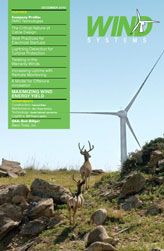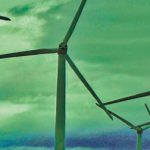With wind energy in North America continuing to grow at an astounding rate, and knowing that legislated requirements are already in force for some states—and right around the corner for others—it is more important than ever to build wind energy power systems that will last. This requires several essential elements, not the least of which is reliable onshore (underground) and offshore (submarine) power cable, along with dependable cable performance standards. Figure 1
From wind developers, to independent power providers (IPPs), to utilities, system reliability is critical and component performance is king. Wind towers and turbines get much of the attention because they are what everyone sees. Granted, tower height, placement, and turbine design are all important to efficiently capture the wind. However, equally as important is what you don’t see; the cables that get power from the base of the tower to the transformer, then to the grid and on to the consumer. Cable design and performance is as important as other wind farm components, and it is absolutely imperative in the ability to provide power transmission and distribution that wind farm owners, utilities, and consumers can count on throughout the life of the entire system. Figure 2
Not All Materials Are Created Equal
Wind power is intermittent, therefore system reliability is crucial. Unplanned cable repairs could be costly in terms of both downtime and maintenance expense. With that in mind, an essential part of that long-term reliability scenario is direct-buried and submarine cable made with quality raw materials and tested to perform according to industry specifications. Let’s start with materials.
There are a number of materials that can be used to construct power cable components: cross-linked polyethylene (XLPE), ethylene propylene rubber (EPR), and polyvinyl chloride (PVC), just to name a few. Cable manufacturers are looking for materials that best meet their needs for ease of processing while producing the performance attributes expected by the end user. In addition, cables are subject to many mechanical and environmental stresses during their lifespan. Flexibility, stress-crack resistance, and shield strippability are all factors to be considered for ease in cable installation. Corrosion kills cables and interrupts power supply. Therefore extreme heat, cold, and water intrusion resistance are paramount. So it becomes more important than ever for cable manufacturers, utilities, wind developers, and others in the value chain to become informed about how various materials perform in power cable applications.
XLPE emerged in the 1970s as the preferred insulation type for medium-voltage (MV) underground (UG) power cables due to its quality, cost competitiveness, and reduced long-term operating costs. However, those early cables were beset with construction and performance issues, limiting the lifespan of some of those cables. This led to the development of “water tree-retardant” XLPE, or TR-XLPE insulation, for underground power distribution cables that have now become the standard bearer. Dow Wire & Cable introduced its DOW ENDURANCE™ MV 4202 TR-XLPE in 1983. Studies show that 27 years later, buried cable made with this material exhibits little to no wear and has an expected lifespan of over 40 years.
As an example, shown in Figure 3, cables made with DOW ENDURANCE TR-XLPE exhibit excellent field operation over time. In addition, TR-XLPE cables have very low dielectric losses compared to EPR cables. In fact, recently updated Rural Utilities Service (U.S. Department of Agriculture) specifications for primary UG power cable (bulletin 1728F-U1) state “plain XLPE has been removed as acceptable insulation and TR-XLPE insulation has replaced it due to the significantly improved reliability.” This longevity and reliability is as important for wind energy power systems as it is for traditional power infrastructure. Wind farms are designed to last for many years and the collection cables must not only last, but must be reliable for the lifespan of the wind farm.
A recent conversation with a Dow customer—cable manufacturer, Southwire—corroborates this. They have provided 35KV power cables for wind farm installations from the Northeast to California, Minnesota to Texas, and many states in between. Common features for typical wind farm cable from Southwire include:
• Aluminum conductors that range in size from 1/0 AWG to 1250 MCM and are “moisture-blocked;”
• TR-XLPE insulation;
• Customized neutral configurations;
• LLDPE jackets that provide good abrasion resistance in UG applications.
“In a nutshell, wind farms have high-cost assets that at times put intense operational burden on the installed cable system,” says Ron Burchfield, director of renewable energy, Southwire Energy Division. “You need to install cables that have been proven to stand up to that challenge. We are convinced that quality manufacturing practices along with quality raw materials are necessary to produce reliable, long-lasting power cable.”
Testing, Validation, and Performance Standards
Many raw materials suppliers and cable makers serve the wind energy market. Not all of these players are created equal either. Research and development at the very front end of the supply chain is very important. When it comes to raw materials, cable makers, developers, IPPs and utilities alike should ask about the kind of technology, clean manufacturing, and packaging techniques, testing, and validation that goes into raw material production. Similarly, end users should insist on specifying cable that has gone through rigorous testing and meets at least the current minimum performance standards set by utilities. Trusting investment dollars to anything less can be risky business.
There are many testing institutes and other organizations that work with companies like Dow Wire & Cable and Southwire to ensure that raw materials as well as the cables produced with those materials, meet recognized national standards. These testing institutes and organizations include National Electric Energy Testing Research and Applications Center (NEETRAC), standards development agencies such as the Association of Edison Illuminating Companies (AEIC), and Insulated Cable Engineers Association (ICEA). In addition, cable makers like Southwire are producing cables that consistently exceed stringent long-term testing standards such as AWTT and ACLT. These long-term testing methodologies demonstrate a proven track record for ensuring long life and reliable cable performance.
No exclusive standards currently exist for cable performance in the wind energy market. So, again, it is important for end users to insist on cables that meet, or preferably exceed, the current power industry minimum standards. Think of it this way: cables form a very small percentage of the total power system cost, and polymeric materials represent an even smaller percentage. Therefore, it is imperative that the renewable energy industry take a broad view to focus on the needed system reliability that rests, to a large extent, on excellent materials, quality cable manufacturing processes and elevated performance standards.
Collaboration is Essential
As with anything worth pursuing, it takes a community of like-minded people to achieve success. The concept of wind power is not new. However, to go from the power needed to turn a millstone to the power needed to light up and connect communities in an efficient and cost-effective manner is quite another story. Collaboration is absolutely essential.
Groups like AWEA and GWEC are certainly helping as they provide a gathering place and information portals for all stakeholders. But we need collaboration in the trenches as well—between investors, developers, IPPs, utilities, equipment, cable, and material suppliers, for example—to realize the energy goals that are or soon will be legislated.
To illustrate the point, cable makers require raw materials that are consistent from batch to batch and demonstrate ease of processing, manufacturing efficiency, and the ability to deliver on the attributes needed for a reliable end product. Utilities require a long-life, reliable power supply at a reasonable cost to them and to the consumer. However, the cable purchasing decision is often made based on cost, without understanding the correlation between what the utility needs in terms of long-term reliability and what a quality cable manufacturer can deliver. All cables are not created equal. At the end of the day, to ensure long-term system reliability, cable purchase and installation decisions need to be based on more than just price.
To that end, companies like Dow Wire & Cable and their valued customers like Southwire are working together not only to validate and adopt superior products for cable construction, but to enhance market awareness about the value of building power systems with the right components, used in the best way to ensure the optimum result for the entire value chain.








































